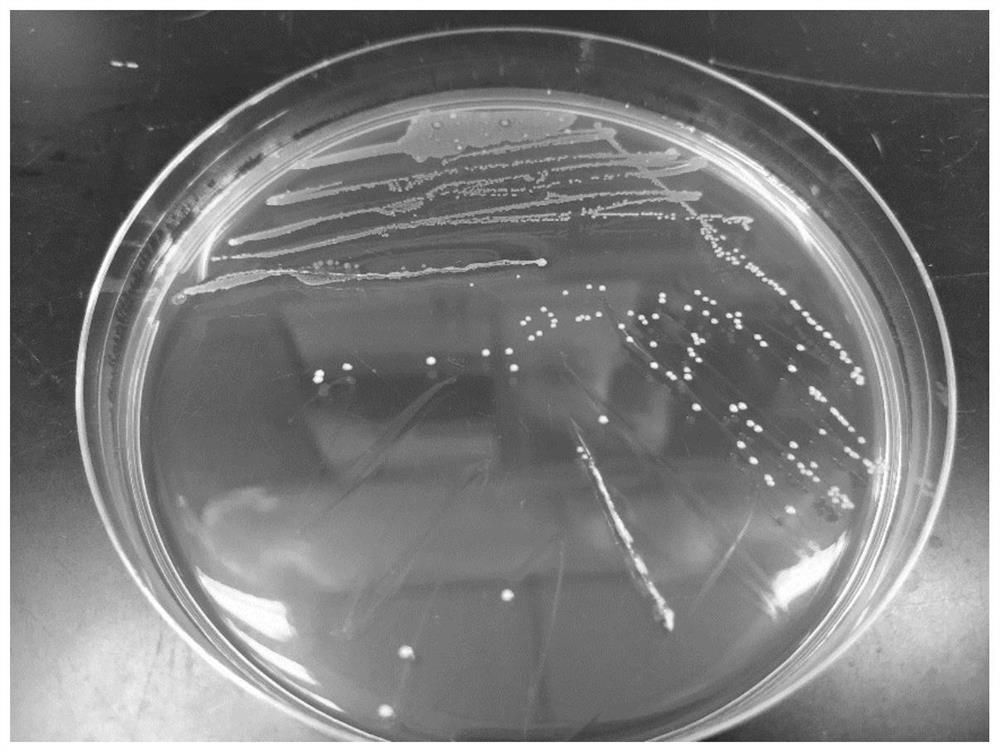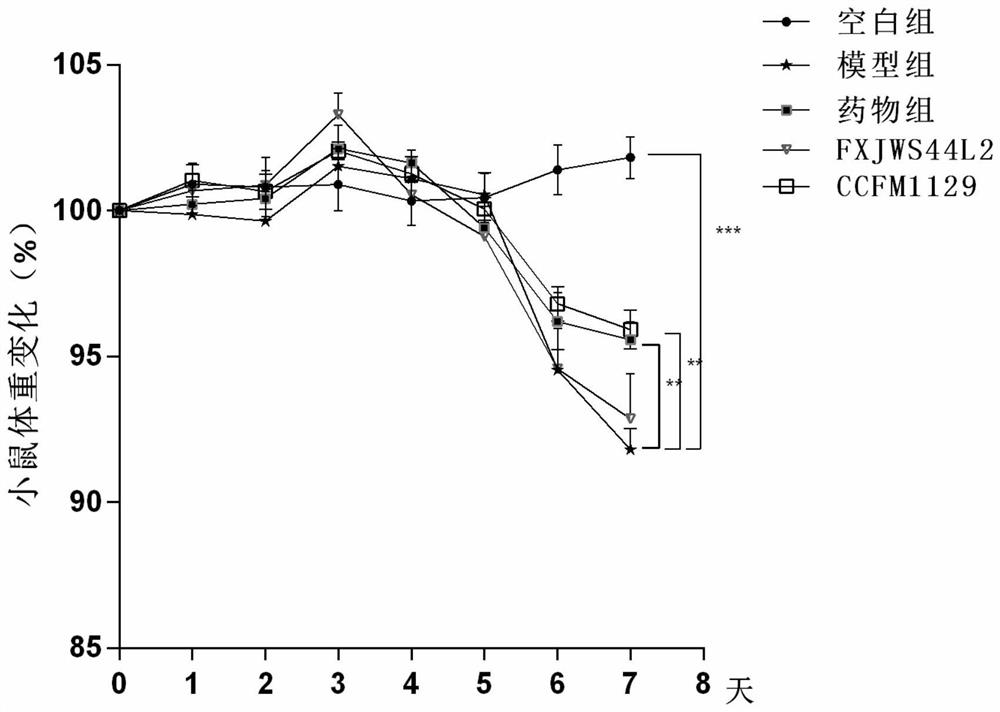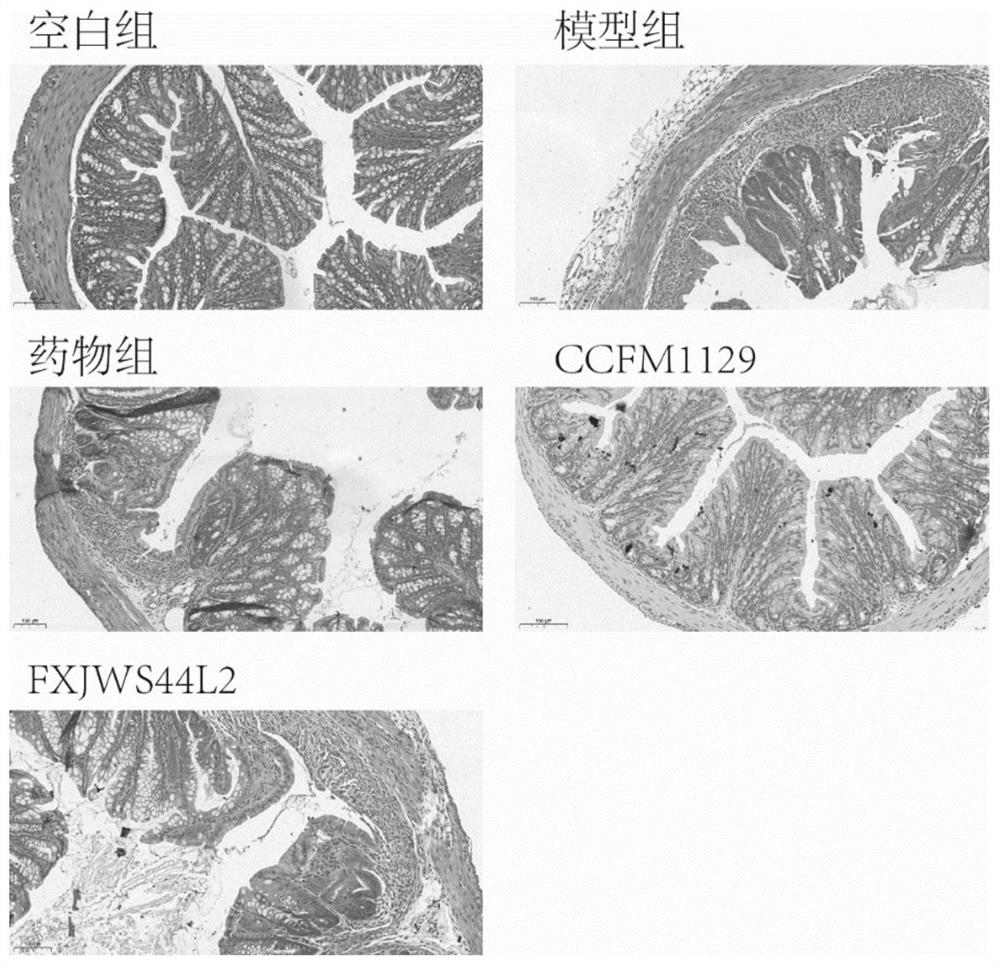Application of lactobacillus rhamnosus to preventing and relieving ulcerative colitis
A technology for Lactobacillus rhamnosus and ulcerative colitis, applied in the field of functional microorganisms, can solve the problems of few strains and poor effect, etc.
- Summary
- Abstract
- Description
- Claims
- Application Information
AI Technical Summary
Problems solved by technology
Method used
Image
Examples
Embodiment 1
[0052] Example 1: Tolerance of Lactobacillus rhamnosus CCFM1129 to simulated gastrointestinal fluid
[0053] The cryopreserved Lactobacillus rhamnosus CCFM1129 was inoculated on the mMRS plate, cultured anaerobically at 37° C. for 48 hours, and subcultured 2 to 3 times with the mMRS culture medium to obtain the culture medium of Lactobacillus rhamnosus CCFM1129.
[0054] Take 1 mL of the culture solution of Lactobacillus rhamnosus CCFM1129, mix it with 9.0 mL of pH 2.5 artificial simulated gastric juice (containing 1% pepsin, mMRS medium at pH = 2.5), and culture it anaerobically at 37°C. Samples were taken at 0.5h, 1h, 2h, and 3h, and the mMRS agar medium was poured to culture the plate colonies, and the number of viable bacteria was determined and the survival rate was calculated.
[0055] Take 1 mL of the culture solution of Lactobacillus rhamnosus CCFM1129 and add it into 9 mL of artificial simulated intestinal fluid (mMRS medium containing 0.3% bovine bile salt, 1% trypsi...
Embodiment 2
[0061] Example 2: Lactobacillus rhamnosus CCFM1129 has no toxic side effects on C57BL / 6J mice
[0062] Resuspend Lactobacillus rhamnosus CCFM1129 in 3g / 100mL sucrose solution to make a concentration of 5.0×10 9 CFU / mL bacterial suspension. Take 6 healthy male C57BL / 6J mice with a body weight of about 14-16g. After adapting to the environment for a week, they are given the bacterial suspension of this concentration by gavage once a day (0.2mL per gavage), observed for a week, and recorded the death and body weight. .
[0063] The results of these tests are listed in Table 3. These results indicated that feeding concentrations of 5.0×10 9 CFU / mL of Lactobacillus rhamnosus CCFM1129 had no significant impact on mice, no significant change in body weight, and no death. The appearance of the mice had no obvious pathological symptoms.
[0064] Table 3 Changes in body weight and death of mice
[0065] time (days) 1 2 3 4 5 6 7 weight(g) 19.53±0.32 19.72±0...
Embodiment 3
[0067] Example 3: Effect of Lactobacillus rhamnosus CCFM1129 on disease symptoms in UC mice:
[0068] Take 30 healthy male C57BL / 6J mice weighing 14-16g, adapt to the environment for 1 week, 6 mice in each group, and randomly divide them into 5 groups: blank group, model group, drug group, Lactobacillus rhamnosus CCFM1129 intervention group (CCFM1129), Lactobacillus rhamnosus FXJWS44-L2 control group (FXJWS44-L2). The dose of intragastric bacterial suspension was 5.0×10 9 CFU / mL, resuspended in 3g / 100mL sucrose solution, 0.2mL per gavage. In the fifth week, dextran sodium sulfate (dextran sulphate sodium, DSS) with a final concentration of 2.5 g / 100 mL was added to drinking water for 7 days to induce colitis in mice. The grouping and treatment methods of experimental animals are shown in Table 4:
[0069] Table 4 Animal grouping and treatment methods
[0070]
[0071] In the fifth week, during the modeling period (DSS treatment period), the body weight of the mice was r...
PUM
| Property | Measurement | Unit |
|---|---|---|
| Thickness | aaaaa | aaaaa |
Abstract
Description
Claims
Application Information
 Login to View More
Login to View More - R&D
- Intellectual Property
- Life Sciences
- Materials
- Tech Scout
- Unparalleled Data Quality
- Higher Quality Content
- 60% Fewer Hallucinations
Browse by: Latest US Patents, China's latest patents, Technical Efficacy Thesaurus, Application Domain, Technology Topic, Popular Technical Reports.
© 2025 PatSnap. All rights reserved.Legal|Privacy policy|Modern Slavery Act Transparency Statement|Sitemap|About US| Contact US: help@patsnap.com



